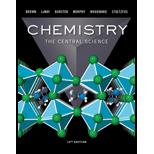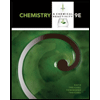
Chemistry: The Central Science Plus Mastering Chemistry with Pearson eText -- Access Card Package (14th Edition)
14th Edition
ISBN: 9780134292816
Author: Theodore E. Brown, H. Eugene LeMay, Bruce E. Bursten, Matthew E. Stoltzfus
Publisher: PEARSON
expand_more
expand_more
format_list_bulleted
Concept explainers
Textbook Question
Chapter 13, Problem 63E
Consider two solutions, one formed by adding 10 g of glucose (C6H12O6) to 1 L of water and the other formed by adding 10 g of sucrose (C12H22O11) to 1 L of water. Calculate the vapor pressure for each solution at 20oC; the vapor pressure of pure water at this temperature is 17.5 torr.
Expert Solution & Answer
Want to see the full answer?
Check out a sample textbook solution
Students have asked these similar questions
k
In Davies' equation log y₁ = log-
log y₁ = log | = -Az² + ✓//
k
A is a constant that always equals 1.02. Correct?
- 0,31
Indicate whether the equality is true Yi
How is it obtained?
k%
Indicate the relationship between the activity coefficient YA and the
rate constant of a bimolecular reaction in solution k and the rate
constant at infinite dilution ko.
Chapter 13 Solutions
Chemistry: The Central Science Plus Mastering Chemistry with Pearson eText -- Access Card Package (14th Edition)
Ch. 13.3 - Prob. 13.1.1PECh. 13.3 - Prob. 13.1.2PECh. 13.3 - Prob. 13.2.1PECh. 13.3 - Prob. 13.2.2PECh. 13.4 - Prob. 13.3.1PECh. 13.4 - Prob. 13.3.2PECh. 13.4 - Prob. 13.4.1PECh. 13.4 - Prob. 13.4.2PECh. 13.4 - Prob. 13.5.1PECh. 13.4 - Prob. 13.5.2PE
Ch. 13.4 - Prob. 13.6.1PECh. 13.4 - Prob. 13.6.2PECh. 13.5 - Prob. 13.7.1PECh. 13.5 - Prob. 13.7.2PECh. 13.5 - Which aqueous solution will have the lowest...Ch. 13.5 - Prob. 13.8.2PECh. 13.5 - Prob. 13.9.1PECh. 13.5 - Prob. 13.9.2PECh. 13.5 - Prob. 13.10.1PECh. 13.5 - Practice Exercise 2
Camphor (C10 H16 O) melts at...Ch. 13.5 - Prob. 13.11.1PECh. 13.5 - Prob. 13.11.2PECh. 13 - Prob. 1DECh. 13 - Rank the contents of the following containers in...Ch. 13 - This figure shows the interaction of a cation with...Ch. 13 - Consider two ionic solids, both composed of singly...Ch. 13 - Which two statements about gas mixtures are true?...Ch. 13 - Prob. 5ECh. 13 - 13.6 If you compare the solubilities of the noble...Ch. 13 - Prob. 7ECh. 13 - Prob. 8ECh. 13 - Prob. 9ECh. 13 - Prob. 10ECh. 13 - Suppose you had a balloon made of some highly...Ch. 13 - Prob. 12ECh. 13 - Indicate whether each statement is true or false:...Ch. 13 - Indicate whether each statement is true or false:...Ch. 13 - Indicate the type of solute-solvent interaction...Ch. 13 - Indicate the principal type of solute-solvent...Ch. 13 - An ionic compound has a very negative H soln in...Ch. 13 - When ammonium chloride dissolves in water, the...Ch. 13 - Prob. 19ECh. 13 - Prob. 20ECh. 13 - Prob. 21ECh. 13 - KBr is relatively soluble in water, yet its...Ch. 13 - The solubility of Cr (NO3)3 . 9 H2O in water is...Ch. 13 - The solubility of MnSO4 . H2 O in water at 20 C is...Ch. 13 - Prob. 25ECh. 13 - Prob. 26ECh. 13 - Prob. 27ECh. 13 - Prob. 28ECh. 13 - Prob. 29ECh. 13 - Prob. 30ECh. 13 - Would you expect stearic acid, CH3 (CH2)16COOH, to...Ch. 13 - Prob. 32ECh. 13 - Prob. 33ECh. 13 - Prob. 34ECh. 13 - Indicate whether each statement is true or false:...Ch. 13 - 13.36 Indicate whether each statement is true or...Ch. 13 - The Henry’s law constant for helium gas in water...Ch. 13 - Prob. 38ECh. 13 - Prob. 39ECh. 13 - Prob. 40ECh. 13 - Prob. 41ECh. 13 - Prob. 42ECh. 13 - 13.43 Calculate the morality of the following...Ch. 13 - Prob. 44ECh. 13 - Calculate the molality of each of the following...Ch. 13 - (a) What is the molality of a solution formed by...Ch. 13 - Prob. 47ECh. 13 - Prob. 48ECh. 13 - Prob. 49ECh. 13 - The density of toluene (C7H8) is 0.867 g\mL, and...Ch. 13 - Calculate the number of moles of solute present in...Ch. 13 - Calculate the number of moles of solute present in...Ch. 13 - Prob. 53ECh. 13 - Describe how you would prepare each of the...Ch. 13 - Commercial aqueous nitric acid has a density of...Ch. 13 - Prob. 56ECh. 13 - Prob. 57ECh. 13 - Prob. 58ECh. 13 - Prob. 59ECh. 13 - Prob. 60ECh. 13 - Prob. 61ECh. 13 - Prob. 62ECh. 13 - Consider two solutions, one formed by adding 10 g...Ch. 13 - Prob. 64ECh. 13 - Prob. 65ECh. 13 - (a) Calculate the vapor pressure of water above a...Ch. 13 - Prob. 67ECh. 13 - At 20 oC, the vapor pressure of benzene (C6 H6) is...Ch. 13 - Prob. 69ECh. 13 - Prob. 70ECh. 13 - Prob. 71ECh. 13 - Prob. 72ECh. 13 - Using data from Table 13.3, calculate the freezing...Ch. 13 - Prob. 74ECh. 13 - Prob. 75ECh. 13 - Prob. 76ECh. 13 - Prob. 77ECh. 13 - Prob. 78ECh. 13 - Prob. 79ECh. 13 - Lauryl alcohol is obtained from coconut oil and is...Ch. 13 - Prob. 81ECh. 13 - Prob. 82ECh. 13 - The osmotic pressure of a 0.010 M aqueous solution...Ch. 13 - Based on the given data in Table 13.4, which...Ch. 13 - (a) Do colloids made only of gases exist? Why or...Ch. 13 - Prob. 86ECh. 13 - An “emulsifying agent” is a compound that helps...Ch. 13 - Aerosols are important components of the...Ch. 13 - Prob. 89ECh. 13 - Soaps consist of compounds such as sodium state,...Ch. 13 - Prob. 91AECh. 13 - Prob. 92AECh. 13 - Most fish need at least 4 ppm dissolved O2 in...Ch. 13 - The presence of the radioactive gas radon (Rn) in...Ch. 13 - Prob. 95AECh. 13 - Prob. 96AECh. 13 - The maximum allowable concentration of lead in...Ch. 13 - Prob. 98AECh. 13 - Prob. 99AECh. 13 - Prob. 100AECh. 13 - Prob. 101AECh. 13 - The normal boiling point of ethanol, is 78.4 0C....Ch. 13 - Prob. 103AECh. 13 - Carbon disulfide (CS2) boils at 46.30 o C and has...Ch. 13 - Prob. 105AECh. 13 - Prob. 106IECh. 13 - At ordinary body temperature (37 o C), the...Ch. 13 - Prob. 108IECh. 13 - Prob. 109IECh. 13 - Prob. 110IECh. 13 - Prob. 111IECh. 13 - Prob. 112IECh. 13 - At 35 o C the vapor pressure of acetone, (CH3)2CO,...Ch. 13 - Prob. 114IE
Knowledge Booster
Learn more about
Need a deep-dive on the concept behind this application? Look no further. Learn more about this topic, chemistry and related others by exploring similar questions and additional content below.Similar questions
- Describe the saline effect that occurs in solutions.arrow_forwardBriefly explain what the infinite dilution rate constant (k∞) consists of.arrow_forwardThe Davies equation corrects the Debye-Hückel limiting law for calculating the activity coefficient of an electrolyte in solution at relatively high concentrations. Mathematically, it is expressed as: log y₁ = -Az²? 1 + √Ĩ - 0,31) Is the formula correct?arrow_forward
- Differentiate between the concepts of "ionic salt effect" and "kinetic salt effect."arrow_forwardDifferentiate the concepts of “salino effect” and “salino kinetic effect”.arrow_forwardCome and compare the Bronsted-Bjerrum calculation, the Debye and Hückel calculation, and the Davies calculation.arrow_forward
- plz watch the youtube video (the title of this topic) by roxi H. she explains it step by step but i get the wrong answerarrow_forwardWriting the rate law implied by a simple mechanism To exit full screen, press and hold esc Suppose the decomposition of ozone proceeds by the following mechanism: step elementary reaction rate constant 1 →>> O3(9) O2(g) + O(g) k₁ 2 03(g) + O(g) → 202(g) k2 Suppose also k₁ »k2. That is, the first step is much faster than the second. Write the balanced chemical equation for the overall chemical reaction: Write the experimentally- observable rate law for the overall chemical reaction. ☐ rate = ☐ Note: your answer should not contain the concentrations of any intermediates. Express the rate constant k for the overall chemical reaction in terms of K1, K2, and (if necessary) the rate constants k-1 and K-2 for the reverse of the two elementary reactions in the mechanism. k = ☐ 000 18 ローロ Ar OOarrow_forwardDeducing a rate law from the change in concentration over time To exit full screen, press and hold esc A chemistry graduate student is studying the rate of this reaction: H2CO3(aq) → H₂O(aq) +CO₂ (aq) - She fills a reaction vessel with H2CO3 and measures its concentration as the reaction proceeds: time (milliseconds) [H2CO3] 0 0.0500 M 10. 0.0266M 20. 0.0181 M 30. 0.0138M 40. 0.0111 M Use this data to answer the following questions. Write the rate law for this reaction. Calculate the value of the rate constant k. Round your answer to 2 significant digits. Also be sure your answer has the correct unit symbol. rate ☐ x10 k = Х 000 18 Ararrow_forward
- Writing the rate law implied by a simple mechanism Suppose the formation of tert-butanol proceeds by the following mechanism: step elementary reaction 1 (CH3)3 CBr(aq) → (CH3)2 C* (aq) + Br (aq) 2 (CH3)2C (aq) + OH¯ (aq) → (CH3)2COH(aq) rate constant k₁ k₂ Suppose also k₁ »k2. That is, the first step is much faster than the second. Write the balanced chemical equation for the overall chemical reaction: Write the experimentally- observable rate law for the overall chemical reaction. Note: your answer should not contain the concentrations of any intermediates. rate = k ☐ Express the rate constant k for the overall chemical reaction in terms of K1, K2, and (if necessary) the rate constants k-1 and K-2 for the reverse of the two elementary reactions in the mechanism. k = ☐ □ ☑ G ? 00. 18 Ar Barrow_forwardDeducing a rate law from the change in concentration over time A chemistry graduate student is studying the rate of this reaction: 2SO3 (g) →>> 2SO2 (g) + O2(g) He fills a reaction vessel with SO3 and measures its concentration as the reaction proceeds: ? time (minutes) [SO3] 0 0.0200M 1.0 0.0105 M 2.0 0.00552M 3.0 0.00290M 4.0 0.00152M Use this data to answer the following questions. Write the rate law for this reaction. rate = k ☐ x10 Calculate the value of the rate constant k. Round your answer to 2 significant digits. Also be sure your answer has the correct unit symbol. k = ☐ Х 000 18 Ar BAarrow_forwardUsing the Arrhenius equation to calculate k at one temperature from k at... The rate constant of a certain reaction is known to obey the Arrhenius equation, and to have an activation energy E reaction is 1.2 × 107 M −1 .S at 160.0 °C, what will the rate constant be at 194.0 °C? Round your answer to 2 significant digits. k = Шм −1 -1 .S ☐ x10 ☑ 5 = = 16.0 kJ/mol. If the rate constant of this a ? olo Ar Barrow_forward
arrow_back_ios
SEE MORE QUESTIONS
arrow_forward_ios
Recommended textbooks for you
 Chemistry: The Molecular ScienceChemistryISBN:9781285199047Author:John W. Moore, Conrad L. StanitskiPublisher:Cengage Learning
Chemistry: The Molecular ScienceChemistryISBN:9781285199047Author:John W. Moore, Conrad L. StanitskiPublisher:Cengage Learning Chemistry & Chemical ReactivityChemistryISBN:9781337399074Author:John C. Kotz, Paul M. Treichel, John Townsend, David TreichelPublisher:Cengage Learning
Chemistry & Chemical ReactivityChemistryISBN:9781337399074Author:John C. Kotz, Paul M. Treichel, John Townsend, David TreichelPublisher:Cengage Learning Chemistry & Chemical ReactivityChemistryISBN:9781133949640Author:John C. Kotz, Paul M. Treichel, John Townsend, David TreichelPublisher:Cengage Learning
Chemistry & Chemical ReactivityChemistryISBN:9781133949640Author:John C. Kotz, Paul M. Treichel, John Townsend, David TreichelPublisher:Cengage Learning Chemistry: Principles and PracticeChemistryISBN:9780534420123Author:Daniel L. Reger, Scott R. Goode, David W. Ball, Edward MercerPublisher:Cengage Learning
Chemistry: Principles and PracticeChemistryISBN:9780534420123Author:Daniel L. Reger, Scott R. Goode, David W. Ball, Edward MercerPublisher:Cengage Learning Chemistry: Principles and ReactionsChemistryISBN:9781305079373Author:William L. Masterton, Cecile N. HurleyPublisher:Cengage Learning
Chemistry: Principles and ReactionsChemistryISBN:9781305079373Author:William L. Masterton, Cecile N. HurleyPublisher:Cengage Learning General, Organic, and Biological ChemistryChemistryISBN:9781285853918Author:H. Stephen StokerPublisher:Cengage Learning
General, Organic, and Biological ChemistryChemistryISBN:9781285853918Author:H. Stephen StokerPublisher:Cengage Learning

Chemistry: The Molecular Science
Chemistry
ISBN:9781285199047
Author:John W. Moore, Conrad L. Stanitski
Publisher:Cengage Learning

Chemistry & Chemical Reactivity
Chemistry
ISBN:9781337399074
Author:John C. Kotz, Paul M. Treichel, John Townsend, David Treichel
Publisher:Cengage Learning

Chemistry & Chemical Reactivity
Chemistry
ISBN:9781133949640
Author:John C. Kotz, Paul M. Treichel, John Townsend, David Treichel
Publisher:Cengage Learning

Chemistry: Principles and Practice
Chemistry
ISBN:9780534420123
Author:Daniel L. Reger, Scott R. Goode, David W. Ball, Edward Mercer
Publisher:Cengage Learning

Chemistry: Principles and Reactions
Chemistry
ISBN:9781305079373
Author:William L. Masterton, Cecile N. Hurley
Publisher:Cengage Learning

General, Organic, and Biological Chemistry
Chemistry
ISBN:9781285853918
Author:H. Stephen Stoker
Publisher:Cengage Learning
Solutions: Crash Course Chemistry #27; Author: Crash Course;https://www.youtube.com/watch?v=9h2f1Bjr0p4;License: Standard YouTube License, CC-BY